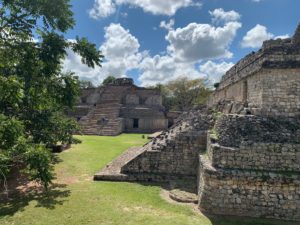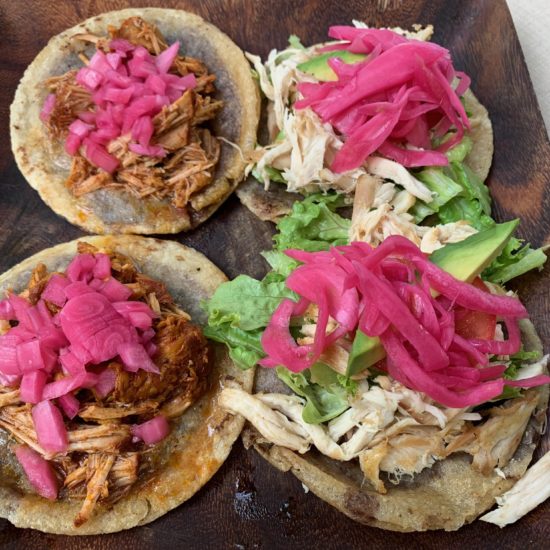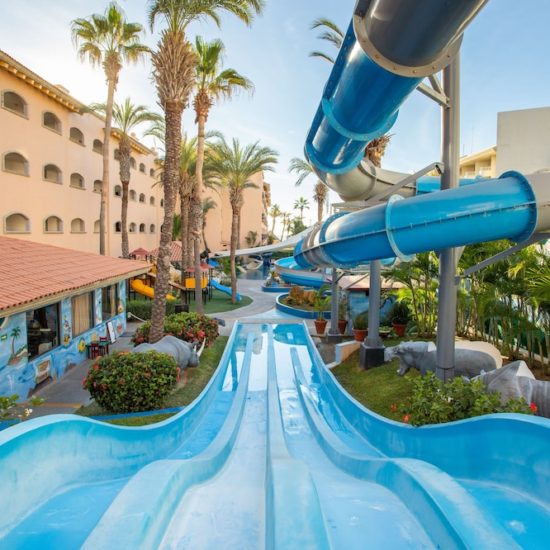
5 Mayan Ruins Closed to Cancun and Riviera Maya
Are you planning a trip to Cancun or the Riviera Maya? As one of the top tourist destinations in South America, this region offers beautiful beaches, luxurious resorts, and vibrant nightlife.
But if you’re looking for a unique cultural experience beyond the typical resort activities, consider exploring some Mayan ruins outside these popular hotspots. You’ll get a taste of ancient history and immerse yourself in the rich culture and traditions preserved for centuries.
In this article, we will explore these incredible Mayan ruins near Cancun and Riviera Maya that are often overlooked by tourists but are worth adding to your travel itinerary. So grab your sunscreen and join us on an adventure through time as we discover these amazing hidden gems.
1. El Castillo at Ek Balam
Ek Balam is an ancient Mayan city in the Yucatan Peninsula, known as the “Black Jaguar” in the Yucatec Maya language. This historical site offers a unique experience for tourists exploring distinctive cultural and historical places.
Here are three key highlights visitors can expect:
- Impressive Acropolis and Royal Tomb: The Acropolis is a monument to the Mayans’ ingenuity—a towering six-level structure 96 feet high, once home to the elite. Venture inside to witness Mesoamerica’s finest tombs, an experience that echoes the grandeur of Mayan ancestry.
- Unique Architectural Features: Ek Balam boasts well-preserved murals, sculptures, and intricate carvings on structures like El Torre pyramid. The site covers approximately 12 square kilometers and features temples, palaces, and a ball court, providing insights into Mayan history and culture.
- Cultural Significance: Ek Balam was an influential city during its peak between 700 and 1000 CE, showcasing evidence of rulers’ wealth and power through its architectural elements. It flourished during the Late Classic Period but eventually declined as other Mayan cities gained dominance.
Additional visitor information
- Entrance Fees: The entrance fee to Ek Balam is approximately 216 MXN, with an additional cost of 50 MXN to visit Cenote X’Canche, located nearby.
- Accessibility: While not wheelchair-friendly due to unpaved paths, the site offers mostly flat ground for easy exploration. Climbing structures like the Acropolis may be challenging for those with height concerns.
- Guided Tours: Visitors can hire certified guides at the entrance for a more informative experience while exploring Ek Balam.
2. El Rey, San Miguelit, and Yamil Lu’um
El Rey, San Miguelito, and Yamil Lu’um are historical and cultural sites in Cancún, Mexico, that offer unique insights into Mayan civilization. These sites are special for tourists seeking to explore ancient ruins amidst the modern resort landscape of Cancún.
Visitors to these locations will enjoy the following:
- Historical Significance: Between the 13th and 16th centuries, the Yucatan Peninsula was home to bustling Mayan hubs such as San Miguelito and El Rey. These sites provide a glimpse into Mayan maritime trade and fishing activities.
- Architectural Marvels: At San Miguelito, visitors can see residential platforms, altars, a palace-like edifice, and a three-story pyramid. El Rey features a small temple and ceremonial platforms, with a sculpture of a noble, possibly a king. Yamil Lu’um offers ancient ruins on a beachside knoll.
Additional visitor information
- Admission fees: The entrance to San Miguelito Ruins costs MXN80, including the Museo Maya de Cancún access. Tickets can be purchased onsite, with the site open Tuesday to Sunday. Climbing on structures is not permitted, and insect repellent is recommended.
- Independent tours: Visitors should be prepared to explore the ruins independently, as no tour guides are available onsite. Additionally, it is advisable to bring insect repellent for protection against mosquitoes during visits.
3. Chichen Itza
Chichen Itza is a renowned archaeological site on the Yucatan Peninsula in Mexico, attracting over 2 million tourists annually. This ancient city was once a significant center of the Maya civilization, housing around 35,000 people at its peak.
Today, it stands as a collection of impressive platforms, temples, and a grand ballcourt, showcasing the architectural prowess of its past inhabitants.
What makes this place special?
- Historical significance: Chichen Itza was a sacred city and pilgrimage center founded by the Itza people in the 5th century AD. It served as a hub for religious ceremonies and trade activities, reflecting the rich cultural heritage of the Mayan civilization.
- Architectural marvels: Visitors can expect to marvel at iconic structures like the Pyramid of Kukulcan (El Castillo), known for its intricate design and unique astronomical alignments. The site also features the Sacred Cenote, a large sinkhole where offerings and sacrifices were made.
- Cultural experience: Exploring Chichen Itza offers insights into Mayan society, rituals, and daily life. The site’s ball court, one of the largest in Mesoamerica, provides a glimpse into ancient Mayan sports and traditions.
Visitor expectations and other information
- Entrance fees: The entry fee for Chichen Itza includes charges from the Institute of History and Anthropology of Mexico and local government taxes. Visitors should be prepared to pay in pesos as credit card facilities may be limited.
- Accommodation: Nearby towns like Pisté offer various accommodation options ranging from highly rated hotels to lodges. Staying close to the site allows visitors to explore Chichen Itza comfortably.
- Best time to visit: To avoid crowds and make the most of your visit, consider arriving early in the morning or later in the afternoon. Spring and autumn equinoxes offer unique opportunities to witness special phenomena like the shadow serpent on El Castillo.
Chichen Itza is a testament to the rich history and cultural heritage of the Maya civilization, offering visitors a captivating journey through time and architecture in one of Mexico’s most iconic archaeological sites.
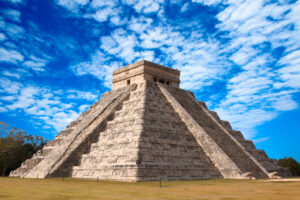
4. Tulum Ruins
The Tulum ruins in Mexico are ancient Mayan remains on limestone cliffs overlooking the Caribbean Sea. Built in the thirteenth century, Tulum was a seaport for trading turquoise and jade, protected by a limestone wall.
The site features structures like the Castillo and the Temple of the Frescoes. Visitors can explore ruins, enjoy views, and swim nearby in the Caribbean waters.
If you visit this place, here’s what to expect:
- Historical marvels: Tulum is home to a renowned archaeological site situated on seaside cliffs overlooking turquoise waters. The ruins offer a glimpse into the ancient Maya civilization and provide a stunning backdrop for exploration.
- Spectacular beaches: Tulum boasts picturesque white sand beaches and crystal-clear waters, making it a top beach destination in Mexico. Visitors can relax on the pristine shores or engage in water activities like snorkeling and surfing.
- Cultural richness: Beyond its archaeological wonders and beaches, Tulum offers a vibrant cultural scene with art galleries, local markets, and traditional Mayan villages to explore. The town is slowly developing, providing a mix of small hotels, restaurants, and shops.
Practical information for visitors
- Entrance fees: The entrance fee to the Tulum Ruins is approximately $5 USD per person.
- Accommodation: Tulum offers a range of accommodation options, from budget cabanas to luxury resorts along the beach strip.
- Travel tips: Visitors are advised to pack light, breezy clothes for the warm climate and consider travel insurance for emergencies..
- Health and safety: It is recommended to avoid drinking tap water in Tulum and opt for bottled or filtered water instead. Additionally, travelers should be cautious with food choices to prevent food poisoning.
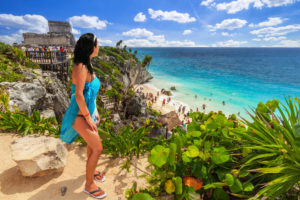
5. Coba Ruins
The Coba Ruins, located in the Mexican state of Quintana Roo, are an ancient Maya city on the Yucatán Peninsula. “Coba” means “waters stirred by the wind,” reflecting its location near two large lagoons.
This archaeological site is unique for its network of stone causeways, known as sacbes, connecting various settlements to the main pyramid, Nohoch Mul. Coba is less excavated and reconstructed than other sites like Chichen Itza or Tulum, allowing visitors to experience a more wild and immersive setting with structures covered by jungle growth.
Here are some of the things to expect from this place and nearby:
- Historical significance: Coba is one of the oldest and largest Maya archaeological sites in Quintana Roo, with evidence of settlement dating back to the pre-Classic period. The site flourished during the Late Classic period, becoming a significant regional capital with strong cultural and political influence.
- Architectural marvels: Coba is renowned for its impressive structures, including the towering Ixmoja pyramid, one of the tallest on the Yucatan Peninsula. The site features a network of sacbes (ancient stone roads) and numerous temples and ball courts that reflect the city’s past glory.
- Natural beauty and adventure: Nestled in the jungle near two large lagoons, Coba offers a picturesque setting for exploration. Visitors can enjoy a refreshing dip in nearby cenotes like Tankach Ha, ChooHa, and Multun Ha, adding an element of adventure to their visit.
Practical information for visitors
- Entrance fees: The cost to enter Coba Ruins is approximately $4, with additional fees for parking and bike rentals.
- Guided tours: Certified guides are available at the entrance for around 500 pesos (USD) for up to 4 people, offering insights into the historical and cultural significance of the site.
- Best time to visit: Exploring Coba in the morning is recommended to avoid the heat and crowds, especially during peak times like Sundays when locals have free access to the ruins.
- Travel tips: Visitors should bring water, good walking shoes, mosquito repellent, and sunscreen for a comfortable exploration experience.
- Accommodation: While Coba can be visited as a day trip from Tulum or Playa del Carmen, staying overnight allows for a more leisurely exploration of the area. Options range from luxury hotels like Coqui Coqui to locally-owned accommodations.
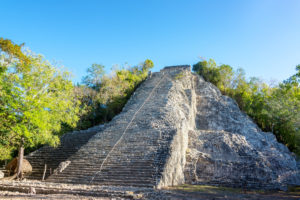
Plan With Holibay and Get the Best Hotel Deals in Cancun and Riviera Maya
While Cancun and the Riviera Maya offer endless opportunities for relaxation and fun in the sun, it’s important not to overlook the rich cultural and historical sites that are scattered throughout the region. The Mayan ruins provide a fascinating glimpse into a civilization that existed thousands of years ago and still leaves us in awe today.
However, as responsible travelers, we must also recognize the importance of preserving these ancient sites and respecting their cultural significance. That is why it’s crucial to be aware of which ruins are open to visitors, as well as follow all rules and regulations when visiting.
Plan your trip with Holibay to make your next vacation memorable and unforgettable. You deserve a stress-free vacation. We’ll look into the best hotel deals in Cancun and Riviera Maya and suggest the best places to visit.



